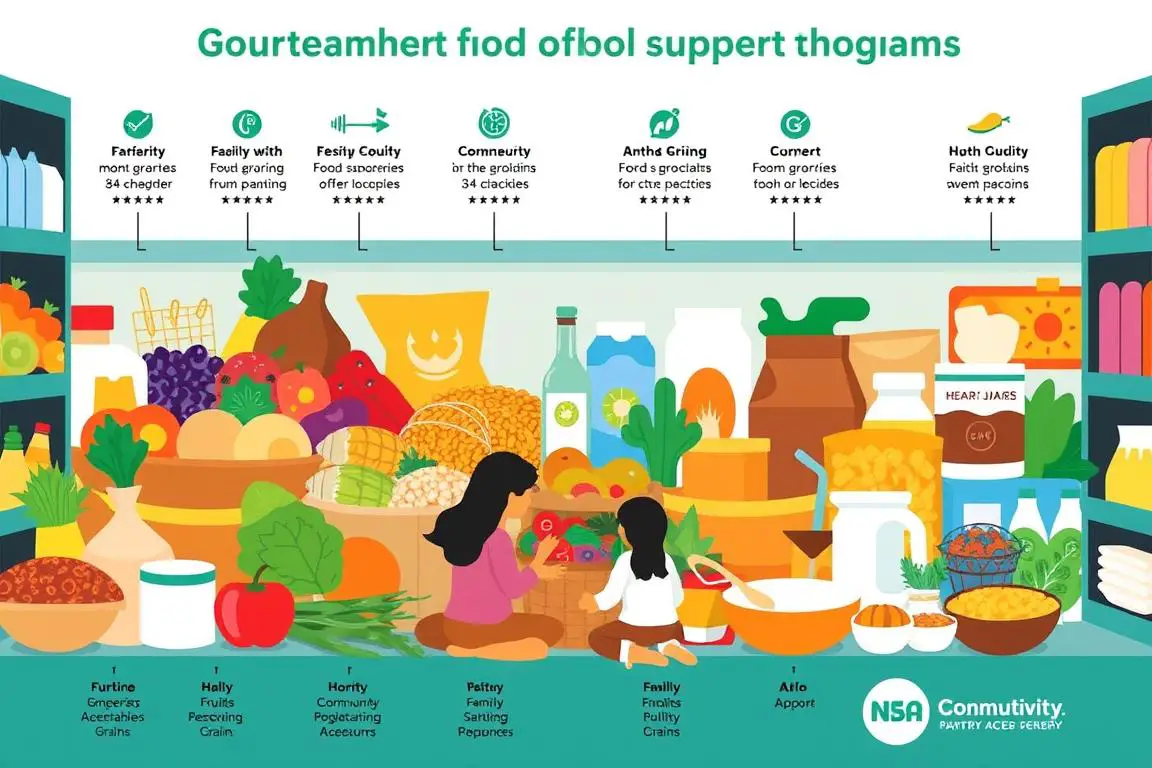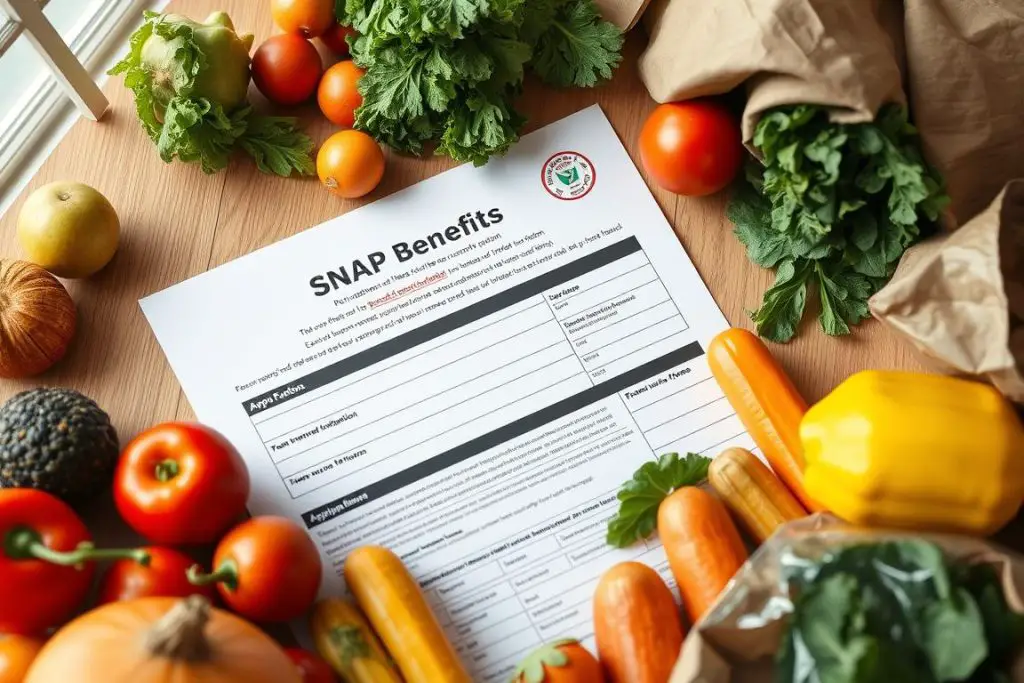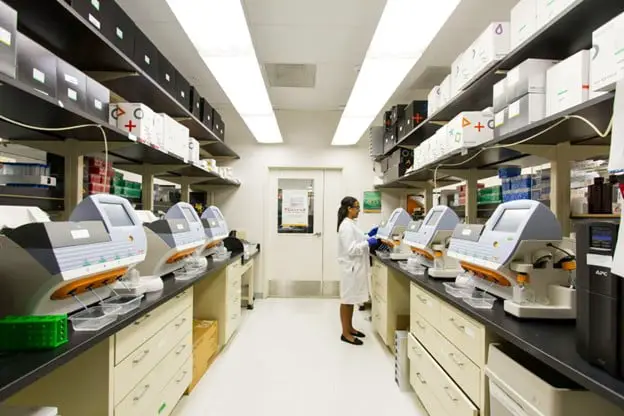Struggling to Afford Groceries? Here’s How Government Food Support Programs Can Help

In the land of plenty, 12.5% of American adults faced food insecurity as of October 20231. This means they sometimes or often didn’t have enough food. Government food support programs like SNAP and WIC offer hope. They help fill the gap between not having enough and having sufficient, providing much-needed relief.
While worrying about food is hard, the growth in SNAP highlights these programs’ strength. From January 2020 to October 20231, SNAP users increased from 37.1 million to 41.4 million. This shows how vital government help is in fighting hunger. But, after extra benefits ended, the average SNAP benefit dropped 28% from February to April 20231, creating new hurdles.
Despite hard times, food assistance stands as a source of kindness and support. Every billion dollars spent on SNAP boosts the economy by $1.5 billion2. It creates thousands of jobs. This helps not just those in need but also strengthens the whole economy.
Key Takeaways
- Government food support programs are essential for families struggling to afford groceries.
- SNAP participation has increased significantly, highlighting widespread food insecurity.
- The value of food assistance benefits can fluctuate, underlining the need for ongoing support.
- Programs like SNAP generate substantial economic activity and job creation.
- Assistance extends beyond immediate hunger relief, impacting poverty rates and community stability.
- Understanding eligibility and benefits can empower those in need to access vital resources.
An Overview of Government Food Support Programs
Learning about government nutrition programs is key for those finding it hard to buy healthy food. These efforts aim to fight food insecurity and cater to different people’s needs. Programs like SNAP, WIC, and others from the USDA help families eat better.
The Role of SNAP: Your Starting Point for Food Assistance
In April 2023, 41.9 million people used SNAP to help buy food. This shows the huge role SNAP plays during tough economic times3. To start getting food assistance, understanding SNAP and how to use its benefits is vital. It links buying power directly to meeting nutritional needs.
How WIC Supports Women, Infants, and Children
WIC focuses on helping low-income women, infants, and children up to five. It provides extra food, health advice, and nutrition education. By doing so, WIC fights childhood obesity and boosts health for those most in need. It shows how specific government programs target early life stages for lasting benefits.
National School Lunch Program: Ensuring Children Have Nutritious Meals
The National School Lunch Program is all about the importance of nutrition in schools. It guarantees nutritious meals for every child at school. This effort fights food insecurity among students, aiding both their studies and health.
USDA’s Commitment: A Closer Look at FNS Nutrition Programs
The USDA’s Food and Nutrition Service runs many programs to end hunger and teach about nutrition. They cover everyone from babies to the elderly. This wide range shows the USDA’s dedication to stopping food insecurity nationally.
Did you know? The USDA made sure over 254,000 places took SNAP benefits in 2021. This makes food accessible everywhere for those who need it3.
Understanding these major parts of government food programs helps you use them well. This means you and your loved ones can eat healthily, even when times are hard.
Understanding SNAP Benefits and Eligibility
If you’re looking for ways to improve your diet on a tight budget, learning about SNAP could help. This program helps people and families lower their food bills with government aid.
Snap benefits are based on the Thrifty Food Plan, which is about the cost of essential foods for healthy home-cooked meals4. The rules say that a household, or people who live and cook together, might also need their own money with SNAP to cover food expenses4.
To get SNAP, your family must meet certain food stamps eligibility rules. You must report assets like cash, bank accounts, and some vehicles, but there are exceptions4. People aged 18 to 50 who can work are usually eligible for SNAP for only three months in a three-year period unless they are working or in training programs4. This rule helps encourage people to become self-reliant.
When applying for SNAP, it’s important to understand the process. For example, if you qualify, you should get your benefits within 30 days of applying4. If there’s an urgent need, you might get benefits in just seven days4.
| Year | Participants | Funding Provided |
|---|---|---|
| April 1965 | 500,000 | – |
| October 1974 | 15 million | – |
| Late 1980s | – | Funding restored to combat hunger |
| 1994 | 27.5 million | – |
| 2014 | – | $31.5 million awarded for fruit and vegetable purchases |
SNAP does more than just offer financial help; it aims to improve the health of Americans by making healthy foods more affordable5. If you need help with SNAP, contact your local SNAP office. Make sure you have all necessary documents ready to make the process smoother.
Government Programs Focusing on Specific Groups
In day-to-day life, it’s key to know about special government programs. They’re made to help different people in our community.
Food Distribution Programs: TEFAP and FDPIR Explained
TEFAP and FDPIR are unique as they offer food help to specific groups. TEFAP gives free emergency food to low-income families6. Meanwhile, FDPIR provides monthly food boxes to eligible Native American families. This ensures they get enough nutritious food from USDA6.
Child Nutrition Programs: Fueling the Future
Child nutrition programs act as a safety net. They provide meals during school and summer breaks. The CACFP helps child and adult care centers give nutritious meals to those in their care6. These programs support our children’s health, making sure they succeed in school and stay healthy7.
Nutrition Programs for Seniors: Addressing the Needs of an Aging Population
There are special nutrition programs for seniors, too. Programs like CSFP improve the health of low-income seniors by giving them nutritious USDA Foods6. Apart from nutrition, Meals on Wheels provides essential social contact for seniors6.
These crucial programs show the government’s effort to improve well-being for all ages. To learn more about these important child nutrition programs, click here.
| Program | Target Group | Key Benefit |
|---|---|---|
| TEFAP | Low-income families | Provides emergency food assistance at no cost |
| FDPIR | Native American families | Monthly food packages |
| CACFP | Children in care centers | Supports provision of nutritious meals |
| CSFP | Seniors (60+) | Supplements diet with nutritious USDA Foods |
| Meal on Wheels | Seniors | Meal delivery and community interaction |
Conclusion
In the world of government food support programs, the vast assistance they offer is crucial. Programs like the essential SNAP benefits and the specialized WIC program provide a safety net for many Americans. Knowing about these programs can greatly help your family’s health and well-being. The improvement and growth of these services, like the overhaul of the Food Stamp Program in 1971, have made a big difference in the battle against hunger8.
The ever-changing nature of USDA food assistance is important to understand. The 2018 Farm Bill, for example, led to increased SNAP benefits by 2021. This change shows the ongoing efforts to make these vital services better9. Still, the challenge of the “SNAP Gap” shows we must keep working hard to fight food insecurity9.
Understanding these food assistance programs does more than just broaden your knowledge—it opens up possibilities for better nutrition and health. Research highlighting SNAP’s positive impact on public health demonstrates the powerful effect of these programs10. In tough times, like economic downturns, natural disasters, or health crises, these services’ flexibility is crucial. For instance, during the COVID-19 pandemic, the USDA quickly approved waivers and introduced online grocery options for SNAP users9. You have the ability to use these resources to ensure your family’s wellbeing, no matter the challenges ahead.
FAQ
What are government food support programs, and who do they help?
How can SNAP benefits assist me with my grocery expenses?
What support does the WIC program offer for women, infants, and children?
Are there school-based meal programs available for children?
What role does the USDA’s Food and Nutrition Service (FNS) play in nutrition assistance?
How do I know if I am eligible for SNAP benefits?
Can seniors access specialized nutrition programs?
What are TEFAP and FDPIR, and how do they differ from SNAP?
Are free food resources available for immediate needs?
How can I apply for food assistance programs like SNAP or WIC?
Source Links
- Food insecurity is impacting one out of eight American adults – https://usafacts.org/articles/food-insecurity-in-the-us/
- The Truth About Food Stamps – Just Harvest – https://justharvest.org/advocacy/the-truth-about-snap-food-stamps/
- What the data says about food stamps in the U.S. – https://www.pewresearch.org/short-reads/2023/07/19/what-the-data-says-about-food-stamps-in-the-u-s/
- Facts About SNAP | Food and Nutrition Service – https://www.fns.usda.gov/snap/facts
- SNAP, Explained | Move For Hunger – https://moveforhunger.org/snap-explained
- Nutrition Programs for Seniors | Nutrition.gov – https://www.nutrition.gov/topics/food-security-and-access/food-assistance-programs/nutrition-programs-seniors
- No title found – https://blog.healthsherpa.com/top-10-government-programs-for-low-income-families/
- History, Background, and Goals of the Supplemental Nutrition Assistance Program – Supplemental Nutrition Assistance Program – https://www.ncbi.nlm.nih.gov/books/NBK206907/
- Supplemental Nutrition Assistance Program (SNAP) – Food Research & Action Center – https://frac.org/programs/supplemental-nutrition-assistance-program-snap
- Links of the Supplemental Nutrition Assistance Program With Food Insecurity, Poverty, and Health: Evidence and Potential – https://www.ncbi.nlm.nih.gov/pmc/articles/PMC6836787/








